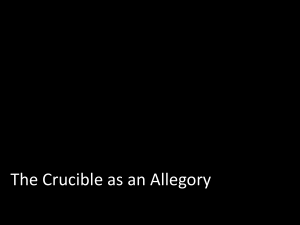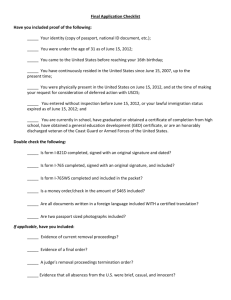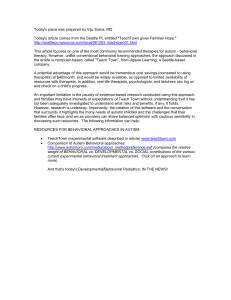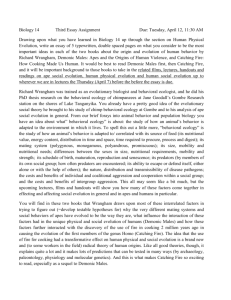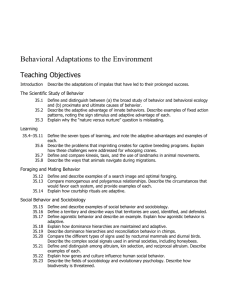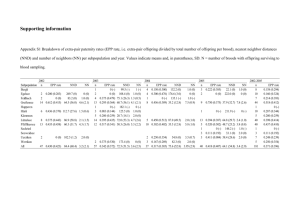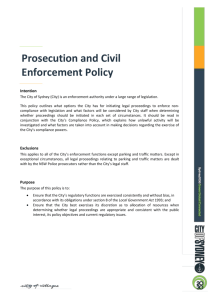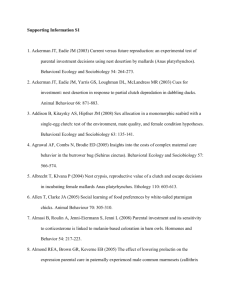Supplemental readings for Animal Behavior
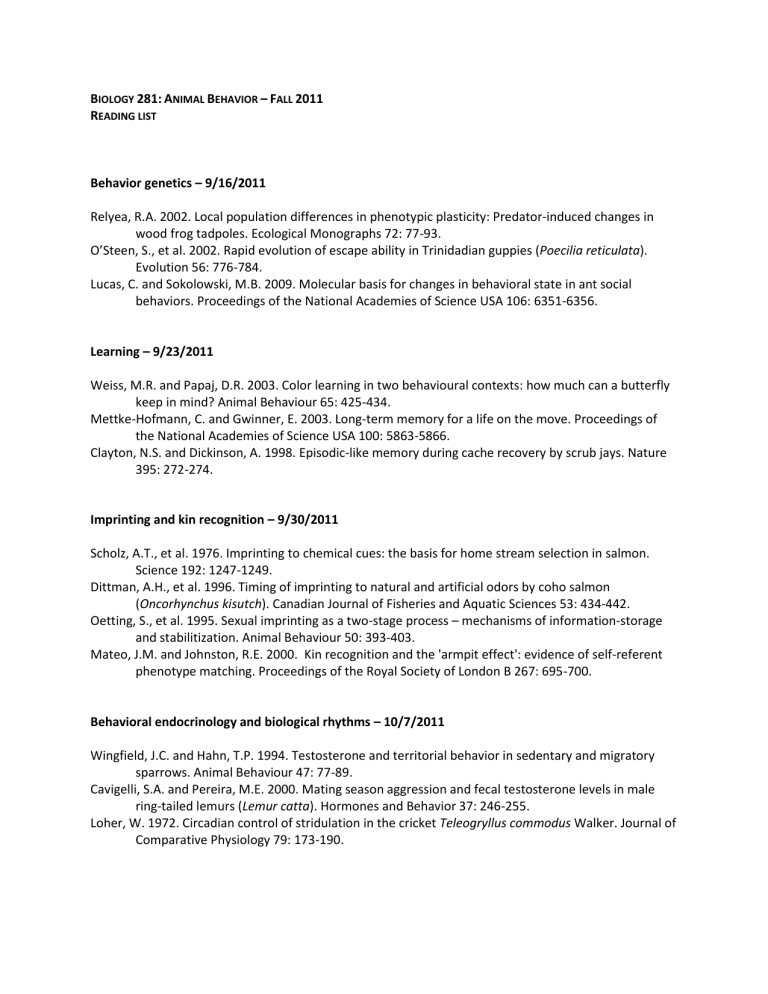
B IOLOGY 281: A NIMAL B EHAVIOR – F ALL 2011
R EADING LIST
Behavior genetics – 9/16/2011
Relyea, R.A. 2002. Local population differences in phenotypic plasticity: Predator-induced changes in wood frog tadpoles. Ecological Monographs 72: 77-93.
O’Steen, S., et al. 2002. Rapid evolution of escape ability in Trinidadian guppies (Poecilia reticulata).
Evolution 56: 776-784.
Lucas, C. and Sokolowski, M.B. 2009. Molecular basis for changes in behavioral state in ant social behaviors. Proceedings of the National Academies of Science USA 106: 6351-6356.
Learning – 9/23/2011
Weiss, M.R. and Papaj, D.R. 2003. Color learning in two behavioural contexts: how much can a butterfly keep in mind? Animal Behaviour 65: 425-434.
Mettke-Hofmann, C. and Gwinner, E. 2003. Long-term memory for a life on the move. Proceedings of the National Academies of Science USA 100: 5863-5866.
Clayton, N.S. and Dickinson, A. 1998. Episodic-like memory during cache recovery by scrub jays. Nature
395: 272-274.
Imprinting and kin recognition – 9/30/2011
Scholz, A.T., et al. 1976. Imprinting to chemical cues: the basis for home stream selection in salmon.
Science 192: 1247-1249.
Dittman, A.H., et al. 1996. Timing of imprinting to natural and artificial odors by coho salmon
(Oncorhynchus kisutch). Canadian Journal of Fisheries and Aquatic Sciences 53: 434-442.
Oetting, S., et al. 1995. Sexual imprinting as a two-stage process – mechanisms of information-storage and stabilitization. Animal Behaviour 50: 393-403.
Mateo, J.M. and Johnston, R.E. 2000. Kin recognition and the 'armpit effect': evidence of self-referent phenotype matching. Proceedings of the Royal Society of London B 267: 695-700.
Behavioral endocrinology and biological rhythms – 10/7/2011
Wingfield, J.C. and Hahn, T.P. 1994. Testosterone and territorial behavior in sedentary and migratory sparrows. Animal Behaviour 47: 77-89.
Cavigelli, S.A. and Pereira, M.E. 2000. Mating season aggression and fecal testosterone levels in male ring-tailed lemurs (Lemur catta). Hormones and Behavior 37: 246-255.
Loher, W. 1972. Circadian control of stridulation in the cricket Teleogryllus commodus Walker. Journal of
Comparative Physiology 79: 173-190.
2
Orientation, navigation and migration – 10/19/2011
Froy, O., et al. 2003. Illuminating the circadian clock in monarch butterfly migration. Science 300: 1303-
1305.
Loymann, K.J., et al. 2001. Regional magnetic fields as navigational markers for sea turtles. Science 294:
364-366.
Cochran, W.W., et al. 2004. Migrating songbirds recalibrate their magnetic compass daily from twilight cues. Science 304: 405-408.
Andel, D. and Wehner, R. 2004. Path integration in desert ants, Cataglyphis fortis: how to make a homing ant run away from home. Journal of Comparative Physiology A 175: 525-530.
Dispersal, habitat selection and territoriality – 10/26/2011
Nunes, S., et al. 1999. Energetic and endocrine mediation of natal dispersal behavior in Belding’s ground squirrels. Hormones and Behavior 35: 113-124.
Hansson, B., et al. 2004. Lifetime fitness of short- and long-distance dispersing great reed warblers.
Evolution 58: 2546-2557.
Kemp, D. J. and Wiklund, C. 2004. Residency effects in animal contests. Proceedings of the Royal Society of London B 271: 1707-1711.
Bergman, M., et al. 2007. Mating success of resident versus non-resident males in a territorial butterfly.
Proceedings of the Royal Society of London B 274: 1659-1665.
Foraging and antipredator behavior – 11/2/2011
Meire, P.M. and Ervynck, A. 1986. Are oystercatchers (Haemoptopus ostralegus) selecting the most profitable mussels (Mytilus edulis)? Animal Behaviour 34: 1427-1435.
Catania, K.C. and Remple, F.E. 2005. Asymptotic prey profitability drives star-nosed moles to the foraging speed limit. Nature 433: 519-522.
Yorzinksi, J.L. and Patricelli, G.L. 2010. Birds adjust acoustic directionality to beam their antipredator calls to predators and conspecifics. Proceedings of the Royal Society of London B 277: 923-932.
Quinn, J.L. and Cresswell, W. 2006. Testing domains of danger in the selfish herd: sparrowhawks target widely spaced redshanks in flocks. Proceedings of the Royal Society of London B 273: 2521-2526.
Communication – 11/9/2011
Srinivasan, M.V., et al. 2000. Honeybee navigation: nature and calibration of the "odometer." Science
287: 851-853.
Riley, J.R., et al. 2005. The flight paths of honeybees recruited by the waggle dance. Nature 435: 205-
207.
Davies, N.B. and Halliday, T. 1978. Deep croaks and fighting assessment in toads Bufo bufo. Nature 274:
683-685.
Ryan, M.J. and Rand, A.S. 1990. The sensory basis of sexual selection for complex calls in the túngara frog, Physalaemus pustulosus (sexual selection for sensory exploitation). Evolution 44: 305-314.
3
Sexual selection and mate choice – 11/18/2011
Gross, M.R. and Charnov, E.L. 1980. Alternative male life histories in bluegill sunfish. Proceedings of the
National Academies of Sciences USA 77: 6937-6940.
Fincke, O. 1984. Sperm competition in the damselfly Enallagma hageni Walsh (Odonata:
Coenagrionidae): benefits of multiple mating to males and females. Behavioral Ecology and
Sociobiology 14: 235-240.
Hill, G.E. 1991. Plumage coloration is a sexually selected indicator of male quality. Nature 350: 337-339.
Andrade, M.C.B. 2003. Risky mate search and male self-sacrifice in redback spiders. Behavioral Ecology
14: 531-538.
Mating systems and parental investment – 12/5/2011
Balmford, A., et al. 1993. Testing hotspot models of lek evolution: data from three species of ungulates.
Behavioral Ecology and Sociobiology 33: 57-65.
Young, K.A. 2009. Hotshots, hot spots, and female preference: exploring lek formation models with a bower-building cichlid fish. Behavioral Ecology 20: 609-615.
Kempenaers, B., et al. 1992. Extra-pair paternity results from female preference for high-quality males in the blue tit. Nature 357: 494-496.
Forster, K., et al. 2003. Females increase offspring heterozygosity and fitness through extra-pair matings.
Nature 425: 714-717.
Social behavior and animal cultural traditions – 12/14/2011
Trivers, R.L. and Hare, H. 1976. Haplodiploidy and the evolution of the social insects. Science 191: 249-
263.
Whitehead, H. 1998. Cultural selection and genetic diversity in matrilineal whales. Science 282: 1708-
1711.
Marcoux, M. et al. 2007. Indications of fitness differences among vocal clans of sperm whales.
Behavioral Ecology and Sociobiology 61: 1093-1098.
